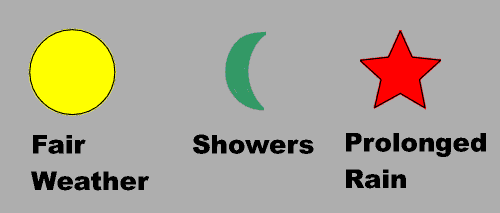 |
 |
| Home | Welcome | What's New | Site Map | Glossary | Weather Doctor Amazon Store | Book Store | Accolades | Email Us |
 | |||||||||
Canada's Weather TrainsIn 1876, Canada began issuing official storm warnings and general weather forecasts, initially relaying them by telegraph from the Toronto, Ontario forecast office to various eastern Canadian centres. By 1879, daily "probabilities," as forecasts were called in those days, were being telegraphed to 125 locations from Ontario to Prince Edward Island for inclusion in daily newspapers and postings on telegraph office, post office, or community bulletin boards. In 1884, the Canada Meteorological Service devised an ingenious system to distribute forecasts to farming communities and farmsteads located too far from population centres to see the postings or quickly receive daily newspapers. They used the railroads that ran regular trains across those agricultural regions to display the forecast message. The initial trial was posted on the morning trains of the Grand Trunk Railway out of Toronto heading into the Grey and Bruce areas of Ontario. Here's how it worked. Early each morning between June and September, local railway agents received the regional forecasts from the Toronto weather office. Depending on the forecast, the agents would affix large metal discs about 3 feet (0.9 m) in diameter into brackets on the side of the locomotive or to baggage cars appropriate for the region through which the trains leaving that morning would pass. For example, trains headed from Toronto toward the Maritimes received forecasts for eastern regions between Toronto and Atlantic Coast. The shape imprinted on the metal disc signified the approaching weather. To farmers working their fields, seeing a full moon (round) disc displayed on a passing train meant fair weather with sunny skies would prevail, a crescent moon signified approaching showers, and a star, prolonged rain. The weather office telegraphed the one-word signal daily at 1 am, and the railway was responsible for displaying the appropriate disc.  At first, the system was well received by farmers across eastern Canada. However, mistrust eventually arose over the posted forecasts because local rail agents did not always keep the forecast signal discs up-to-date. (Some may have been disgruntled because, while the railway and station agents were being paid to post the forecast, the train crews were not compensated for actually doing the work.) As a result by April 1901, the railroad forecast distribution system was dropped. Learn More From These Relevant Books
|
|||||||||
 |
To Purchase Notecard, |
Now Available! Order Today! | |
 |
 |
NEW! Now |
The BC Weather Book: |


